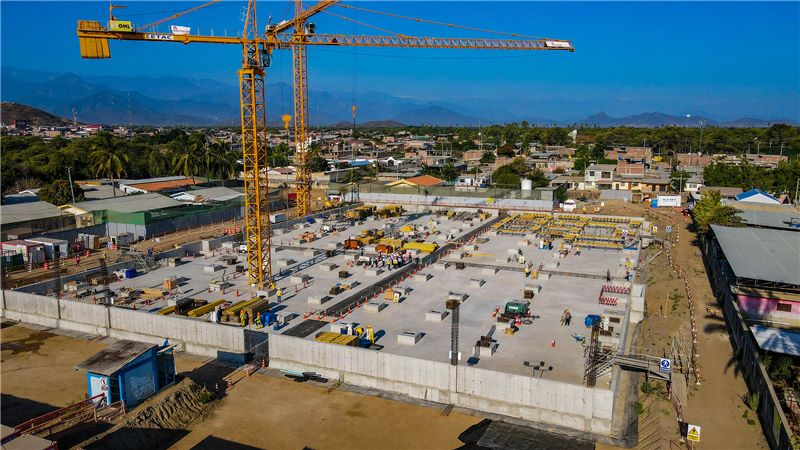Developing nations through G2G construction agreements
Robust in the face of political instability and capable of delivering sustainable development without corruption, Government-to-Government (G2G) agreements are a method the construction sector should look toward to deliver large scale, modern public infrastructure programmes in developing countries.
The G2G model is currently being deployed in Peru with great effect. The United Kingdom Delivery Team (UKDT), a joint venture between Mace, Arup, and Gleeds, is working as Client Partner to the Peruvian ‘National Infrastructure Authority’. UKDT has been working in Peru under a G2G agreement to deliver a strategic reconstruction programme within a broader portfolio focussed on closing the national infrastructure gap, climate resilience and modernisation of social infrastructure.
Weathering climate impacts
Peru’s coastal El-Niño in 2017 tragically caused 169 deaths, the second largest dengue outbreak ever, resulting in impacts to the health and socioeconomic wellbeing of 1.9 million Peruvians (approx. 6% of the population), $3.1 billion of economic losses (approx. 1.6% of GDP), the displacement of 194,000 people, damage to over 300,000 homes - with 65,000 left uninhabitable – and disruption to critical public services including transport, water supply, education and healthcare. The Peru Reconstruction Programme seeks to address the lingering impacts.
To date, the Peru Reconstruction Programme has successfully inaugurated six hospitals and healthcare centres, 50 schools and one flood defence scheme. The programme has also completed the master planning, procurement of design & build contractors and started construction of billions of dollars’ worth of integrated flood defence measures - from early warning radar systems and green infrastructure to urban drainage schemes and river embankment enhancements. The programme is expected to benefit over five million people.
Cyclone Yaku in March 2023 and the El-Niño rains of early 2024 have put the completed infrastructure to the test. It has proven resilient, with healthcare and education services able to continue whilst also serving as refuge spaces for the local communities.
Modernising ways of working
The UKDT has introduced modern methods of working into the programme, enabling the UKDT to support the delivery of over $9bn worth of infrastructure in a timescale previously only matched by the 2019 Pan-American games. The reference to the games isn’t by chance – this was the first G2G agreement used in Peru, under which Mace, Arup and 4global supported the successful delivery of the games and laid the foundations for the other G2Gs that would follow.
These methods include collaborative contracting models, a Programme Management Office (PMO), proactive use of BIM in design development, embedding design to international standards and a focus on operational transition. Many of these methods are standard in the UK but are still emerging in the Peruvian public sector.
The faster pace of delivery means the benefits of the built assets are realised more quickly, enabling earlier provision of improved healthcare and education services whilst protecting communities from future weather events. UKDT has conducted significant formal knowledge transfer activities, alongside upskilling through on-the-job coaching. The learning materials produced by UKDT have also been made available to other government entities at national, regional, and local levels, with the Ministry of Economies and Finance (MEF) adopting a similar training approach. UKDT work has resultingly spearheaded legislative changes in Peru that are embedding global best practices around procurement, collaborative contracts, design, and delivery - creating a legacy that will change infrastructure delivery in the country for generations to come.
Overcoming barriers
Corruption can be a major barrier to the delivery of much-needed infrastructure in developing countries. The G2G model can address this in several ways.
With the backing of the UK Government, the G2G model reduces the risk profile of entering new markets to an acceptable level for private UK companies, and the involvement of international partners gives confidence to the local supply chain who know the procurement processes will be transparent and that contracts will be administered fairly. The G2G model ensures effective communication between members of both governments, meaning escalation routes are always available if required.
Importantly, the G2G model has proven to be robust to political instability. Through the lifetime of the Reconstruction Programme, the UKDT has worked with two client organisations and several changes in their leadership – all without stopping delivery.
The UKDT ensured a transparent and fair procurement process - aligned to UK/OJEU regulation rather than Peruvian laws - which was an effective anti-corruption measure. All Tier 1 procurements for the G2G scope of the Peru Reconstruction programme were self-delivered. UKDT produced contract award recommendation reports and for procurements to be conducted within the G2G framework, the recommendations from these reports had to be implemented.
Another major barrier in emerging economies is finance. Peru enjoys a unique situation where the government often directly finances programmes, however, most developing countries do not have this luxury. In those countries, mechanisms such as export finance to partially fund projects may be applied. Multilaterals such as the World Bank, IMF and Development Banks may offer opportunities to support this. Private finance will also have its part to play, many investment funds are seeking higher returns by entering emerging markets and the G2G model and export finance are some tools which can reduce the risk profile of such investments to make them viable.
Global G2G
The G2G model is not just being used on the Reconstruction Programme. The method is also being used for the bicentennial schools programme, which is delivering 75 new schools around Peru, and is being deployed more broadly in the country, with multiple other nations working to G2G contracts.
As a proven methodology to deliver world-class infrastructure in emerging economies, the G2G is an excellent model for delivering sustainable development and economic growth.
This article first appeared in New Civil Engineer.












